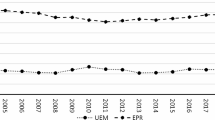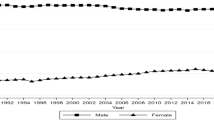Abstract
The aim of this paper is to provide an estimation and decomposition of the motherhood wage penalty in Colombia. Our empirical strategy was based on the matching procedure designed by Ñopo (The Review of Economics and Statistics, 90(2), 290–299, 2008a) for the case of gender wage gaps. This is an alternative procedure to the well-known Blinder–Oaxaca decomposition method. Using the cross-sectional data of the Colombian Living Standard Survey, the wage gap was decomposed into four components, according to the characteristics of mothers and non-mothers. Three of the components are explained by differences in observable characteristics of women, while the other is the unexplained part of the gap. We found that mothers earn, on average, 1.73 % less than their counterparts without children and that this gap slightly decreased when the group included older women. It is observed from the results that, once schooling was included as a matching variable, the unexplained part of the gap considerably decreased and became non-significant. Thus, we did not find evidence of wage discrimination against mothers in the Colombian labor market.

Similar content being viewed by others
Notes
Let us recall that the support of a probability distribution is the closure of the set of possible values of a random variable having that distribution. That is, the set of points that belongs to the distribution.
The common support is the region where the supports of the distributions of characteristics for mothers and non-mothers completely overlap.
Colombian Living Standard Survey of 2008.
The information requirements are higher for this type of techniques. If the researcher only counts with cross-section data (as in our case) and not with panel data, the set of estimation techniques shrinks.
This dummy is equal to 1 if the woman works full time and 0 otherwise.
This procedure could be done in statistical packages such as SAS and Stata. In fact, Ñopo provided a Stata program that allowed us to do the whole matching procedure and gave the results of the earnings gap (Δ) and each of its components.
\( S^{{\overline{M} }} (S^{{\overline{N} }} ) \)corresponds to the set of characteristics that mothers (non-mothers) do not reach.
See Ñopo (2008a) to check the whole procedure.
This survey has been carried out since 1993 with other applications in 1997 and 2003. However, previous questionnaires did not include specific questions about fertility which prevented us from making comparisons over time.
However, the difference between the wage of mothers working full-time and those working part-time was not statistically significant, the same as the case of the wage difference between non-mothers working full-time and part-time.
It is worth noting that different specifications of the schooling variable (three and seven categories) provide highly similar results and they are available upon request.
References
Albrecht, J.W., Edin, P.A., Sundstrom, M., & Broman, S.B. (1999). Career interruptions and subsequent earnings: A re-examination using Swedish data. Journal of Human Resources, 34, 294-311. http://www.jstor.org/stable/pdfplus/146347. Accessed 15 Feb 2012.
Amuedo-Dorantes, C. & Kimmel J. (2008). New evidence on the motherhood wage gap. IZA Discussion Paper No. 3662.
Amuedo-Dorantes, C., & Kimmel, J. (2005). The motherhood wage gap for women in the United States: the importance of college and fertility delay. Review of Economics of the Household, 3, 17–48. doi:10.1007/s11150-004-0978-9.
Anderson, D. J., Binder, M., & Krause, K. (2002). The motherhood wage penalty: Which mother pay it and why. American Economic Review, 92, 354–358. doi:10.1257/000282802320191606.
Anderson, D.J., Binder, M. & Krause, K. (2003). The motherhood wage penalty revisited: experience, heterogeneity, work effort, and work-schedule flexibility. Industrial and Labor Relations Review, 56(2), 273–294. http://www.jstor.org/stable/3590938. Accessed 17 Jan 2011.
Barsky, R., Bound, J., Charles, K., & Lupton, J. (2002). Accounting for the black-white wealth gap: a nonparametric approach. Journal of the American Statistical Association, 97(459), 663–673. doi:10.1198/016214502388618401.
Becker, G. (1985). Human capital, effort, and the sexual division of labor. Journal of Labor Economics, 3(1), S53–58. http://www.jstor.org/stable/2534997. Accessed 17 Jan 2011.
Becker, G. (1991). A treatise on the family. Cambridge: Harvard University Press.
Blinder, A. (1973). Wage discrimination: reduced form and structural estimates. The Journal of Human Resources, 7(4), 436–55. http://www.jstor.org/stable/144855. Accessed 5 Oct 2011.
Bourguignon, F., Ferreira, F., & Leite, P. G. (2008). Beyond Oaxaca-Blinder: Accounting for differences in household income distributions. Journal of Economic Inequality, 6(2), 117–148. doi:10.1007/s10888-007-9063-y.
Buchinsky, M. (1994). Changes in U.S. wage structure 1963–87: An application of quantile regression. Econometrica, 62, 405–458. http://www.jstor.org/stable/2951618. Accessed 5 Oct 2011.
Budig, M. & England, P. (2001). The wage penalty for motherhood. American Sociological Review, 66(2), 204–225. http://www.jstor.org/stable/2657415. Accessed 12 Mar 2012.
Datta-Gupta, N., & Smith, N. (2002). Children and career interruptions: the family gap in Denmark. Economica, 69, 609–629. http://www.jstor.org/stable/3549018. Accessed 17 Jan 2011.
DiNardo, J., Fortin, N. & Lemieux, T. (1996). Labor market institutions and the distribution of wages, 1973–1992: A semiparametric approach. Econometrica, 64(5), 1001–1044. http://www.jstor.org/stable/2171954. Accessed 17 Jan 2011.
Dolton, P.J. & Makepeace, G.H. (1987). Marital status, child rearing and earnings differentials in the graduate labour market. Economic Journal, 97, 897–922. http://www.jstor.org/stable/2233079. Accessed 12 Mar 2012.
Donald, S., Green, D., & Paarsh, H. (2000). Differences in wage distributions between Canada and the United States: an application of a flexible estimator of distribution functions in the presence of covariates. Review of Economic Studies, 67, 609–633. doi:10.1111/1467-937X.00147.
Dupuy, A., & Fernandez-Kranz, A. (2011). International differences in the family gap in pay: the role of labour market institutions. Applied Economics, 43(4), 413–438. doi:10.1080/00036840902950580.
Firestone, J., Harris, R. J., & Lambert, L. (1999). Gender role ideology and the gender based differences in earnings. Journal of Family and Economic Issues, 20(2), 191–215. doi:10.1023/A:1022158811154.
Ganguli, I., Ricardo, H., & Viarengo, M. (2011). The closing of the gender gap in education: does it foretell the closing of the employment, marriage and motherhood Gaps? Harvard Kennedy School, RWP11-021.
Hansen, J., & Wahlberg, R. (2005). Endogenous schooling and the distribution of the gender wage gap. Empirical Economics, 30(1), 1–22. doi:10.1007/s00181-004-0218-4.
Harkness, S., & Waldfogel, J. (2003). The family gap in pay: evidence from seven industrialized countries. Research in Labor Economics, 22, 369–414. doi:10.1016/S0147-9121(03)22012-4.
Jenkins, S. P. (1994). Earnings discrimination measurement-a distributional approach. Journal of Econometrics, 61, 81–102. doi:10.1016/0304-4076(94)90078-7.
Juhn, C., Murphy, K. & Pierce, B. (1993). Wage inequality and the rise in returns to skill. The Journal of Political Economy, 101(3), 410–442. http://www.jstor.org/stable/2138770. Accessed 5 Oct 2011.
Kanji, S. (2011). Labor force participation, regional location, and economic well-being of single mothers in Russia. Journal of Family and Economic Issues, 32, 62–72. doi:10.1007/s10834-010-9198-z.
Korenman, S., & Neumark, D. (1992). Marriage, motherhood, and wages. Journal of Human Resources, 27, 233–255. http://www.jstor.org/stable/145734. Accessed 12 Mar 2012.
Lundberg, S., & Rose, E. (2000). Parenthood and the earnings of married men and women. Labour Economics, 7, 689–710. doi:10.1016/S0927-5371(00)00020-8.
Molina, J. A., & Montuenga, V. (2009). The motherhood wage penalty in Spain. Journal of Family and Economic Issues, 30, 237–251. doi:10.1007/s10834-009-9153-z.
Moro-Egido, A. (2012). Changing trends of mothers’ active and passive childcare times. Journal of Family and Economic Issues, 33, 11–23. doi:10.1007/s10834-011-9265-0.
Nielsen, H. S., Simonsen, M., & Verner, M. (2004). Does the gap in family-friendly policies drive the family gap? Scandinavian Journal of Economics, 106, 721–744. doi:10.1111/j.0347-0520.2004.00385.x.
Ñopo, H. (2008a). Matching as a tool to decompose Wage Gaps. The Review of Economics and Statistics, 90(2), 290–299. doi:10.1162/rest.90.2.290.
Ñopo, H. (2008b). An extension of the Blinder–Oaxaca decomposition to a continuum of comparison groups. Economics Letters, 100(2), 292–296. doi:10.1016/j.econlet.2008.02.011.
Ñopo, H., Daza, N. & Ramos, J. (2011). Gender earnings gaps in the world. IZA Discussion Papers 5736, Institute for the Study of Labor (IZA).
Oaxaca, R. (1973). Male-female wage differentials in urban labor market. International Economic Review, 14(3), 693–709. http://www.jstor.org/stable/2525981. Accessed 17 Jan 2011.
Olarte, L., & Peña, X. (2010). El efecto de la maternidad sobre los ingresos femeninos. Revista Ensayos de Política Económica, 28(63), 190–231.
Piras, C. & Ripani, L. (2005). The effects of motherhood on wages and labor force participation: evidence from Bolivia, Brazil, Ecuador and Peru. Sustainable development department technical papers series WID-109, IDB, Washington DC.
Sigle-Rushton, W., & Waldfogel, J. (2007a). The incomes of families with children: a cross-national comparison. Journal of the European Social Policy, 17(4), 299–318. doi:10.1177/0958928707082474.
Sigle-Rushton, W., & Waldfogel, J. (2007b). Motherhood and women’s earnings in Anglo-American, Continental European, and Nordic countries. Feminist Economics, 13(2), 55–91. doi:10.1080/13545700601184849.
Waldfogel, J. (1998a). The family gap for young women in the United States and Britain: can maternity leave make a difference? Journal of Labor Economics, 16, 505–545. http://www.jstor.org/stable/10.1086/209897. Accessed 12 Mar 2012.
Waldfogel, J. (1998b). Understanding the family gap in pay for women with children. Journal of Economic Perspectives, 12, 137–156. http://www.jstor.org/stable/2646943. Accessed 17 Jan 2011.
Wellington, A. (1993). Changes in the male/female wage gap, 1976–1985. Journal of Human Resources, 28(2), 383–411. http://www.jstor.org/stable/146209. Accessed 12 Mar 2012.
Acknowledgments
The authors gratefully acknowledge financial support from Universidad Icesi. We also thank Hugo Ñopo, Ximena Peña, Natalia González, Juan Carlos Guataquí, Nohora Forero, and three anonymous reviewers for their valuable suggestions. The reviewers’ constructive assessments helped us to improve the quality of the paper. Finally, we thank Adriana Caicedo for helpful research assistance.
Author information
Authors and Affiliations
Corresponding author
Appendix
Appendix
Rights and permissions
About this article
Cite this article
Gamboa, L.F., Zuluaga, B. Is There a Motherhood Penalty? Decomposing the Family Wage Gap in Colombia. J Fam Econ Iss 34, 421–434 (2013). https://doi.org/10.1007/s10834-012-9343-y
Published:
Issue Date:
DOI: https://doi.org/10.1007/s10834-012-9343-y




